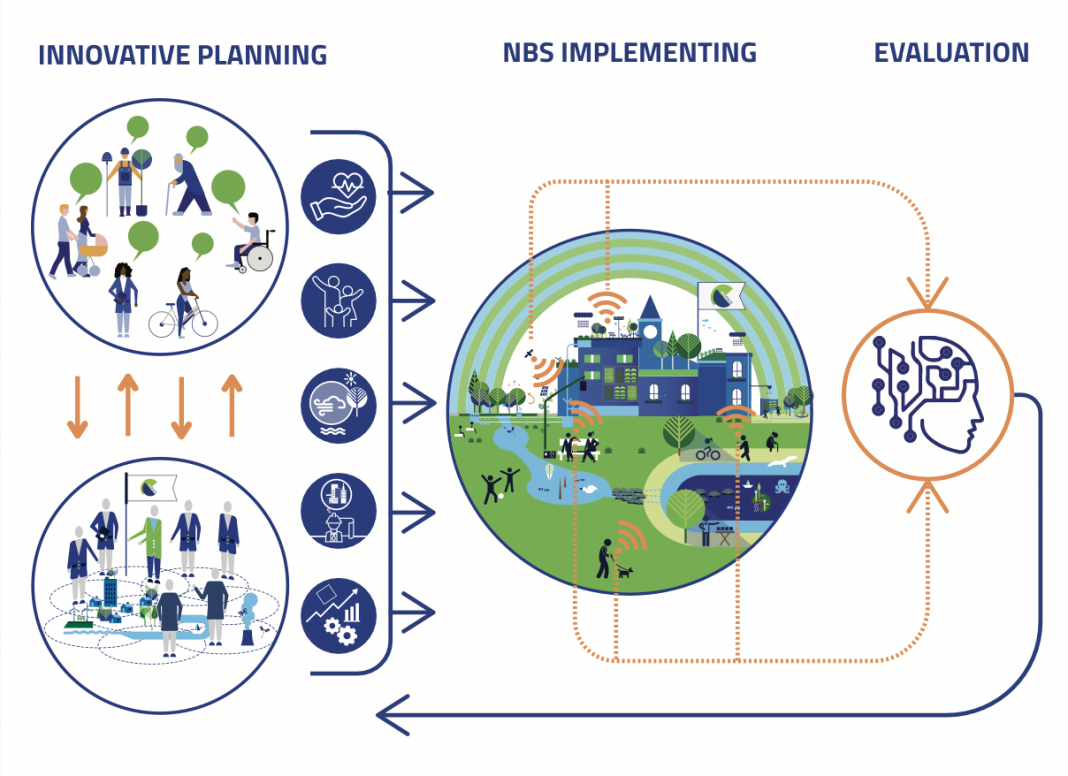The adverse effects of urbanization have taken a toll on people’s mental and physical health, here’s how co-design and nature-based solutions can lead the way in mitigating these risks
Back in the 1800’s people started moving from rural to urban areas. This urbanization process was motivated by many factors, including better education, housing, access to work, and less time and expense of commuting and transportation. For many years, an increasing trend of urbanization was observed, followed by set of harmful phenomena, such as alienation, increased cost of living, and mass marginalization. Today, we are facing the consequences that emerged.
Urbanization is affecting mind, body and soul
The adverse effects of urbanization took a toll on peoples’ mental and physical health. On the one hand, mental health is affected by stressors and factors, such as overcrowded and polluted environment, high levels of violence, and reduced social support. On the other hand, urbanization is associated with increased risk of asthma, due to the exposure to air pollutants, such as nitrogen dioxide (NO2) and carbon monoxide (CO). Both cases require for prompt actions/solutions.
However, it is not easy to accept that there are cost-effective solutions, which simultaneously provide environmental, social, and economic benefits and help build resilience. If we add that these solutions are inspired and supported by nature, people will reject the concept as a non-feasible idea. Fortunately, that is not the case. Nature-based solutions (NBS) is exactly what is needed to tackle most of the problems raised by increasing urbanization trends.
Addressing urbanization via nature-based solutions
The euPOLIS project addresses the challenge of targeted nature-based small-scale interventions. Usually, before taking any action to handle a situation, someone would start gathering related information. Yet, information implies participation, emphasizing on the residents or shopkeepers located close to the areas of interest. Attention should be provided to gender, age, and disability perspectives within the process. At the end of the day, the planned NBSs should be accessible to everyone.
The creation of inclusive and accessible urban spaces dictates to systematically implement gender mainstreaming strategies. It, also, promotes the adoption of novel participatory tools, into all phases and processes of project development. This is to ensure that the needs of diverse groups are considered. If you provide people with pleasant socializing open areas, which stimulate social exchange, an improvement in lifestyle will be the
outcome. Yet, the creation of such an area calls for the active participation of the citizens in the planning process.
Keeping in mind local, human need
Generally, participatory processes should be tailored to local needs and context, promoting a human-centric planning. The challenge lies in successfully gathering the views of the multiple social groups, including marginalized people, which are, by definition, largely absent in public forums. Bringing these people and perspectives into planning processes is not a straightforward task. Participatory research is one way that these perspectives can be articulated, through the deployment of a range of research techniques.
Building an ecosystem that addresses residents’ needs, can be sustainable, and abides to the constraints of the local climate, is a challenging task that requires information exchange, at all stages of the process: a) preparation, b) construction and c) utilization. In each stage, people can provide insights and ideas that will help with the process and probably, maximize the impact of the intervention. Citizens’ participation will help co-design the interventions and monitor the integration process. The latter case can be involved into a co-evaluation process.
Giving back the power to residents in urbanised areas
In euPOLIS, we see public participation as an opportunity for building not only nature-based solutions that match the diverse needs of local communities but also for building social capital and consequently increasing social cohesion. However, to reach both goals, it is necessary to plan and execute public participation that is inclusive for diverse groups of citizens, easy and accessible for all stakeholders, based on two-way communication, and gives decision-making power to the citizens, and foremost is part of the long-term strategy that promotes citizens’ participation.
Furthermore, the project includes the monitoring and assessment of the impact of all interventions. Generated knowledge will be used for model calibration, NBS evaluation, interactive modelling visualization and web-based dissemination/communication activities. The goal is to complement the monitoring of the carried-out interventions Citizens, city authorities, policymakers, psychologists, sociologists, and communication experts will be engaged during the adaptation of the euPOLIS solutions to ensure it is practical and user-friendly, while respecting all relevant privacy issues.
Data and monitoring of outcomes
Data can be obtained through sensor networks, wearables, surveys, websites, and remote sensing. Each of these data sources has a specific contribution. There will be weather stations and pollution (or other type of) sensors installed at the intervention areas, complemented by satellite imagery. Data collection will, also, involve a group of volunteers. EuPOLIS will provide them with the wearables, which will be used for monitoring the emotional status, stress/anxiety levels, and physical health indicators.
The progress and the outcomes of introducing specific regenerative measures, as primary planning criteria, will be constantly monitored, allowing the involving parties to keep track on the goals, and adjust their strategies when necessary. The adopted approaches will be evaluated in four cities around Europe, namely: Belgrade (Serbia), Gladsaxe (Denmark), Lodz (Poland), and Piraeus (Greece). The know-how is, already, propagated in other cities, including Bogota (Colombia), Limassol (Cyprus), Palermo (Italy), Trebinje (Bosnia and Herzegovina).
For more information click here.
Acknowledgments: This publication is supported by the European Union Funded project euPOLIS” Integrated NBS- based Urban Planning Methodology for Enhancing the Health and Well-being of Citizens: the euPOLIS Approach” under the Horizon 2020 program H2020-EU.3.5.2., grant agreement No 869448.
Co-authors: National University of Athens: Anastasios Doulamis, Eftychios Protopapadakis, Nikolaos Doulamis
Affiliations: Maja Lalić and Ksenija Pantelić, Mikser Association
National Technical University of Athens
- Tel: +30 210 772 2676
- www.eupolis-project.eu
- YouTube


